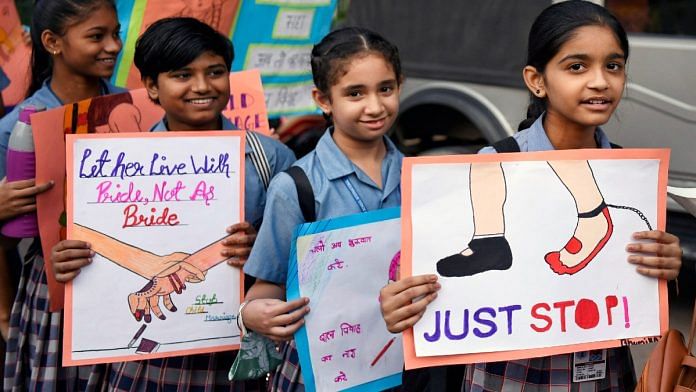The Supreme Court has issued new guidelines against child marriage—a vexed issue for West Bengal, which still seems stuck in the past. The court has mandated that every district appoint a Child Marriage Prohibition Officer to keep a hawk eye out to prevent such marriages. Similar rules have been formulated before to address the issue that social scientists blame on poverty, illiteracy, and tradition. And while these efforts have had an impact nationally—child marriages in India dropped from 54.2 per cent in 1992-93 to 23.3 per cent in 2019-21, as per the National Family Health Survey data—West Bengal has held steady at around 41 per cent, bracketing itself with Bihar and Tripura as one of the worst-performing states.
West Bengal has a child marriage problem. It’s defying its own haloed history.
The state has everything going for it to reverse the trend. Tradition, to start with. Remember Bengal abolished sati around 200 years ago and introduced widow remarriage 25 years later. More recently, the state earned kudos from UNICEF for its Kanyashree Prakalpa programme—a cash transfer scheme to keep girls in school and prevent child marriage. Yet, young girls in Bengal are still marrying young.
Child marriage, reimagined
Baffled bureaucrats, social scientists, and economists are, however, noticing a glimmer of hope in a phenomenon that has not officially been tabulated, but is becoming more visible: self-initiated marriages. More and more girls are marrying just before they turn 18, in a way, asserting their right to choose their partner even if it means losing financial benefits from the state. Girls are not willing to wait until they turn 18 and risk their parents forcing them into a marriage of their choosing, not hers. Girls are rebelling, becoming assertive—and that is something to celebrate, even if it destroys West Bengal’s child marriage statistics.
But what about education? The trend of self-initiated marriage just short of 18 has forced some social scientists to recognise that education for education’s sake is not enough of an incentive. Nor is incentivising education with money. Girls—and boys—who spend 18 years of their lives in school want worthwhile returns on that investment. But given the scarcity of jobs, they don’t find much to look forward to. So, for girls, the next option often is: let’s get married.
In fact, three districts in West Bengal are identified as the worst performers on child marriage front—Murshidabad, West Midnapore, and East Midnapore. The irony is, East Midnapore ranks also has the highest literacy rate in the state. Clearly, literacy is no reason for girls not to marry young. In fact, literacy might possibly be the trigger fuelling their assertiveness and determination to choose their own partners, even if they are underage.
Also read: WhatsApp is helping activists stop child marriage in Maharashtra’s Beed
Bengal, caught in a loop
The problem they are running into is: who to marry? Boys in West Bengal are dropping out of school at an alarming rate because nearly all incentives are focussed on girls, leaving boys out in the cold. So, in a crunch, if a family needs an extra pair of hands to earn money, the trend is: let’s pull the boy out of school—not the girl. She is at least contributing to the family purse by getting government grants, the boy is not, so let’s put him to work.
The fallout of that is, more girls than boys are taking the secondary exam in West Bengal, classrooms in girls’ schools are packed, while boys’ schools are emptying out. This is resulting in a breed of young men whose education is incomplete, who are deployed to earn money for the family via vocational skills with not the brightest prospects from a young age.
Many boys are forced to leave home in search of work, often outside the state. And when parents want to tie them to the family and house, their solution is: marry him off. No parent wants the bahu to be more educated than the son or older. So, for their 18-year-old school dropout son who is on the threshold of turning into a migrant labourer, they go hunting for a bride who is younger, less read. Net result? Another nail in the coffin of West Bengal’s child marriage statistics.
Welcome as they are, the Supreme Court’s latest directives on child marriage don’t tackle the infinite socio-economic complexities that make India. Let’s not even get into whether these rules supersede personal laws of different religious orders.
The good news is, despite the odds, child marriage rates have plummeted overall in India. States that were at the bottom of the list have taken giant leaps forward. For West Bengal, the way forward must be to collaborate and adopt best practices from other states. The scourge of child marriage must go. West Bengal cannot afford to lag behind—its people deserve better.
Monideepa Banerjie is a senior journalist based in Kolkata. She tweets @Monideepa62. Views are personal.
(Edited by Prashant)







West Bengal have TMC problem.
Why was Mamata Banerjee not married off as a child?
She would not have been the headache she is today.
West Bengal has a TMC problem. It’s a cancerous tumour. The whole of it must be surgically removed for the body to become healthy again. Periodic checkups too are required to ensure there is no recurrence of the tumour.